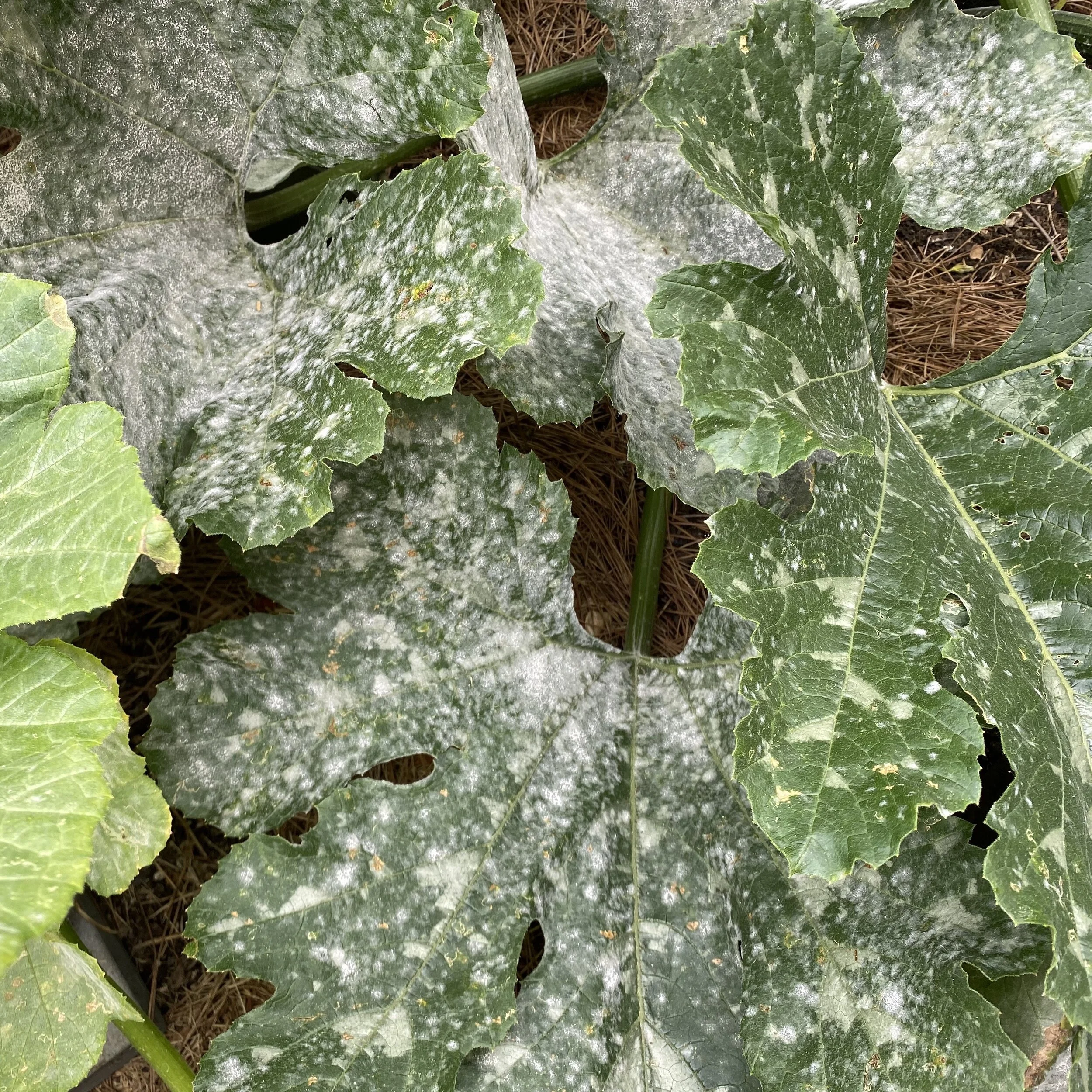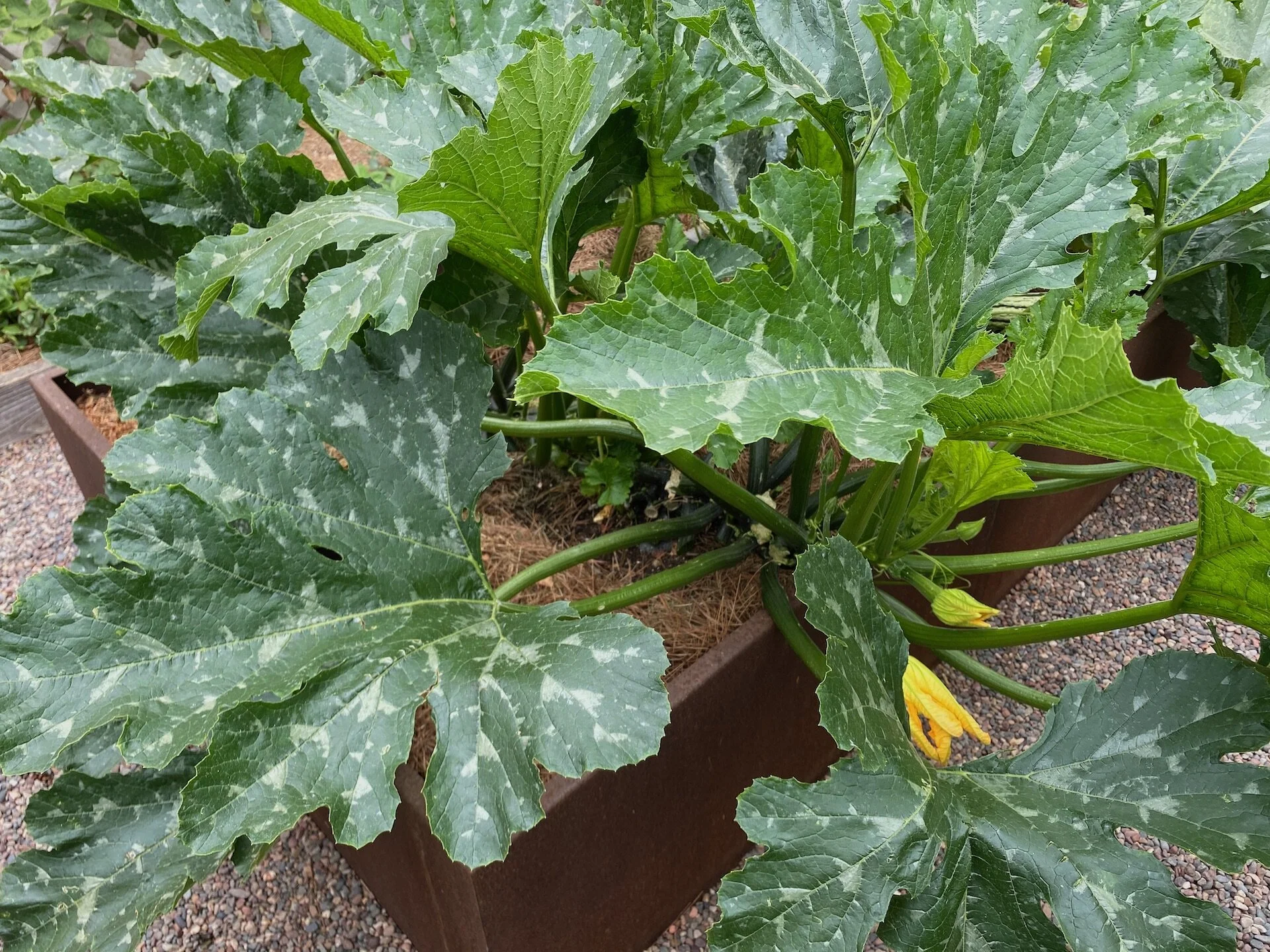Powdery Mildew
Repost and an update August 2022: Powdery mildew showed up right on schedule. I noticed that my original post was August 14, 2020. I arrived home from a week-long vacation yesterday and this is what I found.
Here are photos of my zucchini, zinnias, English cucumbers and butternut squash. Before vacation, I carefully removed any zucchini foliage that with powdery mildew. None of the other plants showed any evidence of the fungal disease.
My plan for tomorrow is to remove all of the zucchini plant foliage with powdery mildew. Fortunately, the plant has headed off in a new direction and is free of disease so I can expect continued production, especially with a dousing of liquid fish-seaweed fertilizer.
Some experts recommend removing diseased zucchini plants and starting over. My garden is small and in September I’ll be readying the raised beds for cool season crops—likely before I’d get fruit. I think I’m done with zucchini for the season and probably my neighbors!
My treasured, seed-grown ‘Queen Red Lime’ zinnias will get a good shower early in the morning. The foliage will dry by the afternoon. In other years, this has worked remarkably well. I’ll repeat as needed to keep these gorgeous blooms and plants going strong.
I’m reluctant to remove butternut squash leaves but I’ll give them the same sprinkling. The cucumbers will stop producing in a few weeks but they’ll get liquid fish-seaweed fertilizer to keep new growth and fruit coming on.
Here’s my original post with more info about powdery mildew and recommendations to make plants less susceptible.
I’m sitting on my front porch writing about the powdery mildew that is overtaking my backyard vegetable garden. It’s expected in the usual susceptible plants grown in my coastal summer garden—tomatoes and the squash; but the powdery mildew is early this year. I’ve groused in other blogposts about May Gray and June Gloom that lingered into July and now August. Usually by the Fourth of July most of the fog and overcast departs.
The powdery mildew is not only early, but it’s affecting other plants that don’t usually have the problem. The bell peppers have a light case. This past spring my beet greens and carrot tops developed powdery mildew but the crops recovered with new growth. Predictably, my winter sweet peas and snow peas ended their season with powdery mildew. As I sit in the shade of the ‘Purple Robe’ locust, I see the dropped leaves also have the coastal scourge.
Eventually, my cucumbers give up and rather suddenly say the season is over with powdery mildew dealing the final blow. But this year the lower two-thirds of the plants are heavily mildewed while healthy vines climb the trellis with new fruit set.
If this were mid-September, I’d say we’ve had a good run, remove most of the summer veggies and make preparations to plant the cool season garden in late September and October. But I’ve not given up on tomatoes, peppers, cucumbers, zucchini and the other squash; and it’s too early to plant the fall crops.
Powdery mildew causes irregular yellow blotches on tomato leaves.
As with Growing Tomatoes in the Fog Belt, I’m finding other ways to live with the climatic conditions and the powdery mildew that it brings. My friend, Brijette at San Diego Seed Company reminds me that in urban gardens we work with the constraints of our garden conditions and adapt.
My go to source when I have garden problems is UC IPM (University of California Integrated Pest Management Program). Here’s their opener for powdery mildew.
White powdery growth on leaves and shoots can be a sign of powdery mildew. This disease affects many plants, and one of several fungi can cause it. Manage powdery mildew by growing resistant plant varieties and altering the growing environment. In some situations, fungicide treatments might be required for susceptible plant species.
The UC IPM Powdery Mildew Quick Tips makes these suggestions for management of the disease.
ALTER THE GROWING ENVIRONMENT TO MAKE PLANTS LESS SUSCEPTIBLE
Grow plants in sunny locations.
Provide good air circulation by pruning excess foliage.
Fertilize properly because too much nitrogen causes lush foliage and shade, providing conditions for fungal growth.
CONSIDER NON-CHEMICAL METHODS
Wash spores off infected plants with overhead sprinkling. To prevent other disease problems, do this midmorning so moisture dries rapidly.
Prune out small infestations and remove infected buds during the dormant season. Quickly remove infected materials so you don’t spread spores.
For suggestions to control severe powdery mildew using commercial oils or plant oils such as neem oil, sulfur or biological fungicides, see the recommendations at the UC IPM link Powdery Mildew on Vegetables.
Another resource on Powdery Mildew is How to Treat Powdery Mildew on Plants which includes some additional explanations about conditions that promote the growth of powdery mildew. The site offers other suggestions for treatment such as baking soda combined with liquid soap and water. Some garden writers use a milk spray:
A mixture of one part milk (any kind) to five parts water sabotages the onset of powdery mildew, a common fungal disease that weakens plants by stopping up their stomata. Nothing will cure cucurbit powdery mildew once it gets going, but milk sprays and trimming off old leaves will keep it at bay until the plants make a good crop. Barbara Pleasant in a recent Facebook post.
Photo of powdery mildew by Max Planck Institute.
Here’s what I do to manage powdery mildew in my vegetable garden. To sum it up in a sentence, I trim affected leaves frequently and after a major clean-up add some worm compost (or regular compost) around the plant and douse the soil with liquid fish-seaweed emulsion fertilizer. To this regimen I’ve recently added an early morning spray of the foliage of affected plants to wash off the spores. The cleansing was dramatic for my zinnias.
My zucchini plant after trimmed of powdery mildew leaves.
My zucchini, squash and cucumbers respond well with new healthy growth to support continued fruit production Tomatoes are a lost cause now, though I trim the dying leaves every few days hoping that enough foliage remains to ripen the fruit. The pepper crop is bountiful but the plants are not beautiful. I occasionally remove diseased leaves but I won’t have peppers at Thanksgiving as usual.
Gardening is about experimentation. This year I’ll add “and adapting.” Let me know how you deal with powdery mildew in a comment. We learn from each other.
To leave a comment, click on “Leave a comment/Show comments,” enter the comment, then insert your name. Email address and website URL are optional. Finally, click on “Comment as Guest” to post comment. Subscribe to ediblegardens52 by email in Comments.










